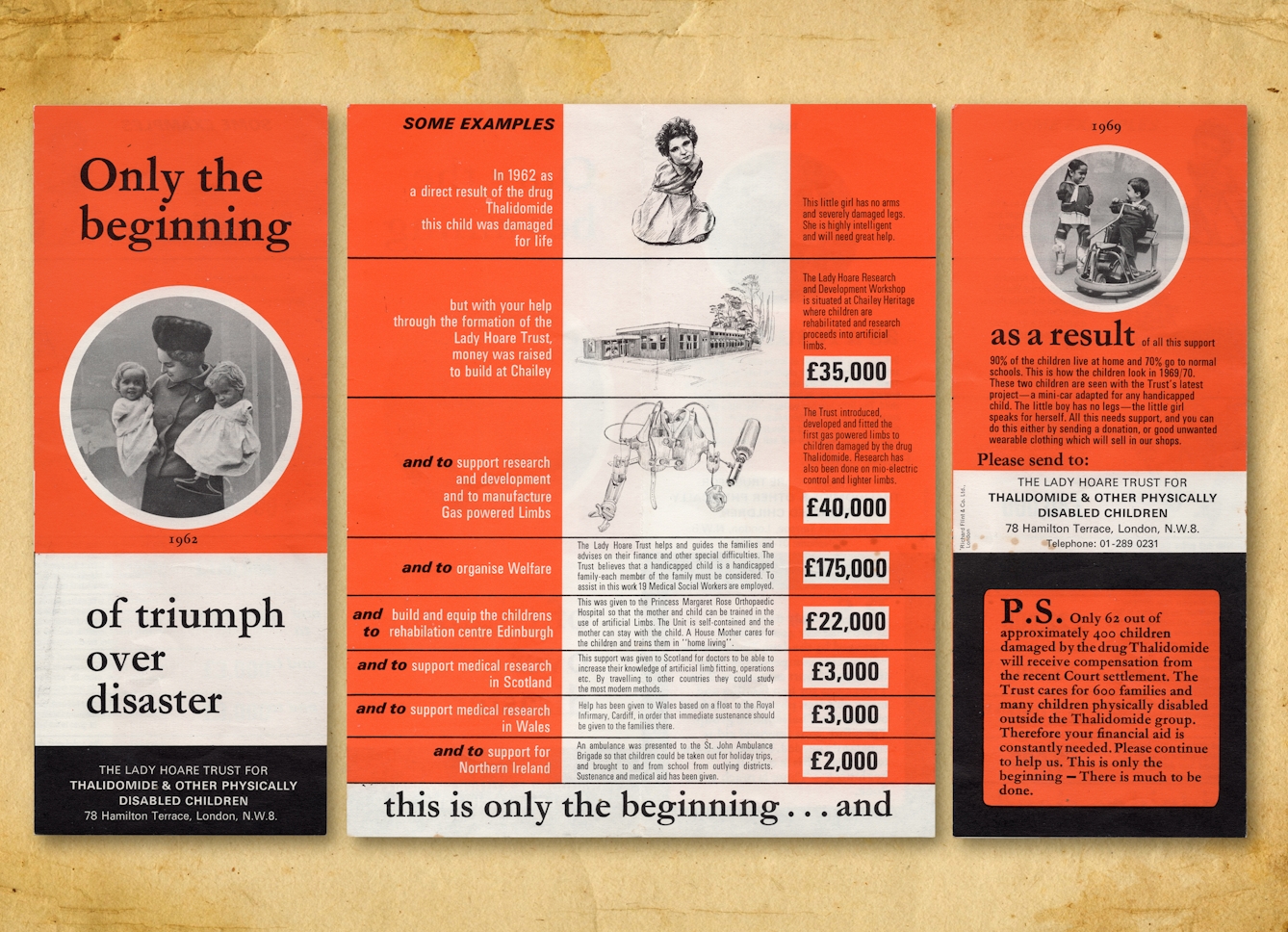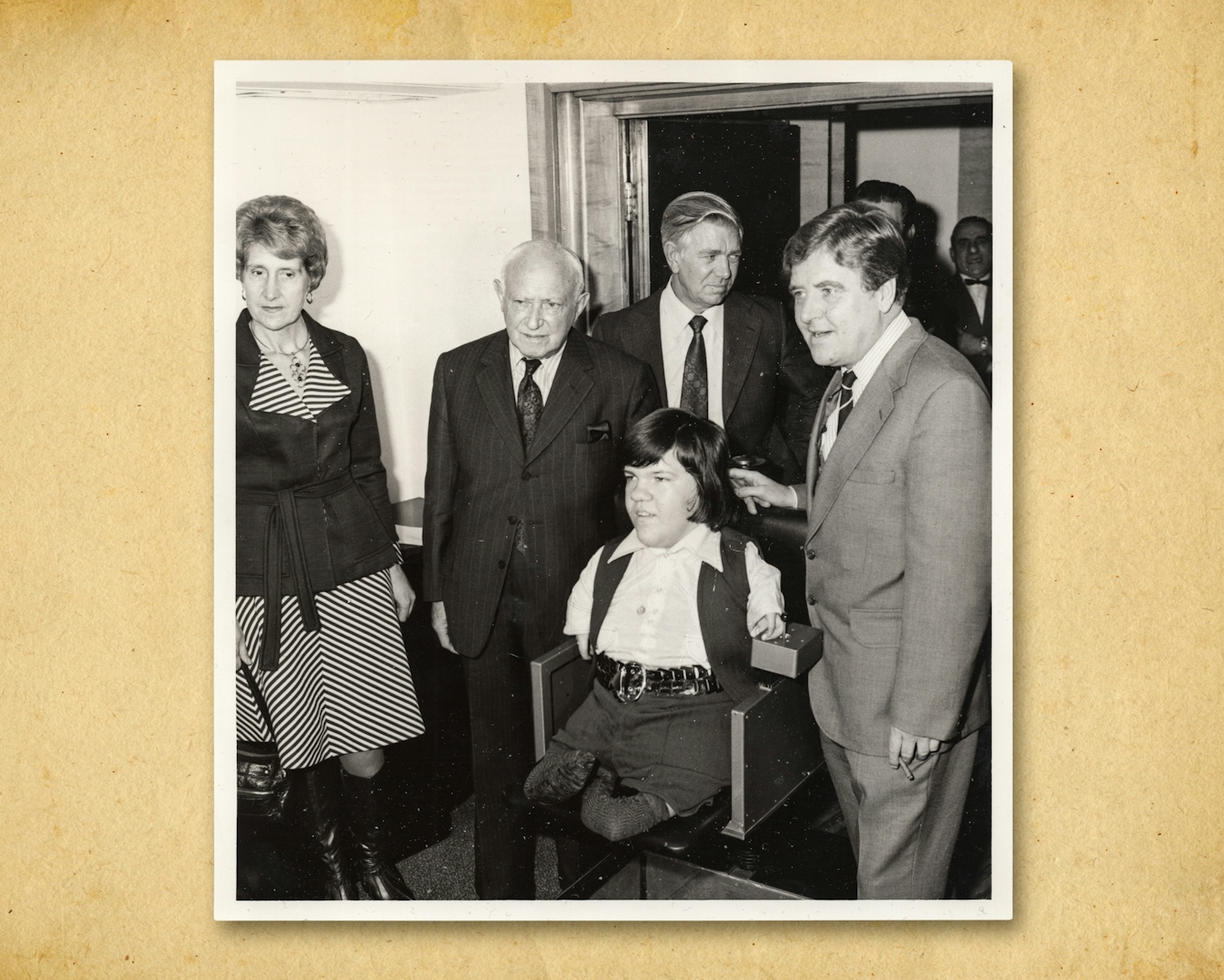With pharmaceutical companies reluctant to admit responsibility and the government slow to offer support to thalidomide survivors, their frustrated families had no option but to take on the pharmaceutical industry themselves in a decades-long battle to win fair compensation and justice.
Families fighting for justice
Words by Ruth Blueartwork by Hollie Chastainaverage reading time 5 minutes
- Serial

The damage caused by thalidomide to the unborn foetus was well known by the end of the 1950s. Distaval and other thalidomide-based products sold by Distillers in the UK had been withdrawn in 1961, but despite the mounting evidence about the damage the drug had caused, little was done to help the families affected.
While thalidomiders took on the challenges of growing up in an able-bodied world, their families grew increasingly frustrated by the lack of action on the part of government, and denial and retrenchment on the part of Distillers and Chemie Grünenthal.
Parents came together to see what could be done, and found themselves faced with lawyers, the media and increased attention from the general public for the first time.
The Society for the Aid of Thalidomide Children
As the news of the damage caused by thalidomide broke in the press, local parent groups organised across the country, largely through newspaper appeals. They wanted to provide mutual support and to discuss how most effectively to fight for recognition and justice.
These groups began to join forces and, to considerable media attention, a group of parents from across the UK came together on 20 October 1962 in London. This was to be the inaugural meeting of the Society for the Aid of Thalidomide Children, today known as the Thalidomide Society. By the end of 1963, the Society had 425 members.
Many UK thalidomide survivors have grown up together attending Society meetings, forming what they frequently refer to as a “large dysfunctional family”. This is undoubtedly one of the strengths of the UK thalidomide network.

Information leaflet and call for donations and second-hand clothing by the Lady Hoare Trust for Thalidomide & Other Physically Disabled Children, 1969.
Soon after its foundation, the Society joined forces with the Lady Hoare Thalidomide Appeal, which had been launched nationwide by Lady Mary Hoare, wife of the then Mayor of London, to raise money for thalidomide families. This grew into the Lady Hoare Trust for Thalidomide & Other Physically Disabled Children, which co-ordinated its activities with the Society, focusing their efforts on providing immediate aid, recruiting specialist social workers and organising healthcare.
Donations from the public, raised by both bodies, were coordinated, though the legal and compensation-campaign issues were left to the parents. At this point, no compensation or government support was available.
Compensation battles
In 1968 Distillers finally proposed a compensation sum equivalent to 40 per cent of assessed damages to be awarded to 62 families. While seemingly a financial lifeline for families on very low incomes, the offer was totally inadequate for a lifetime of support. To compound this, inflation was not taken into account.
The families found themselves under great pressure to accept the offer or risk losing out altogether. Dave remembers the pressure put on his parents to sign a legal agreement and the upset that it caused his father in particular.
He came home after school to find three people urging his parents to sign the financial settlement agreement: “I saw me father weeping – and he’s been in the army for 27 years; he was as hard as frigging nails – and he was crying because he just didn’t know what to do, and he was forced to sign it.”
Given this kind of pressure and with some families urgently in need of financial support, many of them accepted the Distillers offer, but the company insisted that all the families must agree to the settlement if any were to receive funds. Six families refused to sign the agreement and there was a stalemate.
Gaining public attention
In the early 1970s, Harold Evans, then editor of the Sunday Times, led a media campaign in support of the thalidomide survivors and their families. The campaign was part of a renewed focus on the moral, rather than legal, justice of the situation. As well as the newspaper campaign, MP Jack Ashley campaigned in Parliament and the families themselves promoted their cause in the media.

Beatrice and Ed with Manny Shinwell, Alf Morris and Jack Ashley. Many thalidomiders met and were photographed with key political figures of the time.
Louise described herself as one of the “poster girls” during the campaign for compensation. Her father David Mason was one of those who rejected the Distillers offer, but he fought relentlessly for justice. His doggedness and refusal to accept the inadequate settlement changed Louise and other survivors’ lives immeasurably. Louise admired her father and appreciated his determination, but his efforts came at a cost to their relationship.
Louise.
After several more years of negotiation, and building on the 1968 settlement, a final settlement was agreed by Distillers in 1973. This included a lump-sum payment for a further 367 children affected by thalidomide in the UK (on the same basis as the initial 62). Distillers paid £20 million to the newly established Thalidomide Children’s Trust (today known as the Thalidomide Trust) to provide “support and assistance” – including annual grants – to all thalidomide survivors.
Disability assessments
Before the families could receive any funds, each child had to be assessed for eligibility through physical examinations and proof, usually from a mother’s medical records, that thalidomide had been taken. Many survivors describe those examinations as degrading.
Kath remembers being asked to stand on a table, balanced on unstable prosthetic legs and wearing only a pair of knickers; her mum was not allowed to help her as she stood crying, afraid of falling, while her photograph was taken.
This was a common experience. Often mothers were asked to leave the room while the young child was photographed, interrogated, and tested to assess their physical capacity. As adults, survivors recall that they had no idea why they were being asked to do these things, and had they known, it would have made a difference to their performance.
When explanations were given, they were often upsetting and confusing, as in Julia’s case.
Julia.
Following the initial assessments, children were separated into two categories. Children on the X List were confirmed to have thalidomide-related impairments. Children on the Y List had a more uncertain diagnosis and consequently their compensation was reduced or denied. Over the years, many children were moved from the Y List to the X List, but some had to wait years for reassessment.
Today the Thalidomide Society continues to support its members, while a dedicated campaign team of survivors continues to fight for justice. The Thalidomide Trust ensures that the remaining thalidomide survivors get the care and support they need by managing and distributing money from the financial settlement.
About the contributors
Ruth Blue
Dr Ruth Blue is a freelance writer, researcher and oral historian with a PhD in fine art from the Slade School of Fine Art. She worked for Wellcome for 17 years, where she began working with thalidomide survivors in 2013, collecting their stories, photographs and artefacts. She has continued this work for the Thalidomide Society.
Hollie Chastain
Hollie Chastain is a mixed-media artist and award-winning illustrator living and working in Chattanooga, Tennessee. Coming from both a graphic-design and studio-art background, her work has a storytelling quality, mixing found material, strong graphic elements and modern palettes. Along with gallery work, she has illustrated work for Smithsonian Magazine, Warner Music and the Oxford American, among others, and authored and illustrated a book published in 2017. She currently works from a home studio with her husband Eric, two children, two cats and two dogs.

